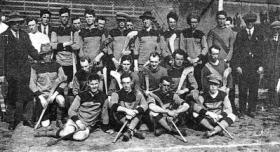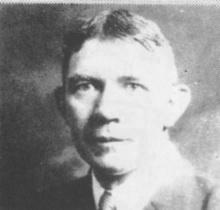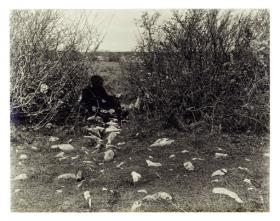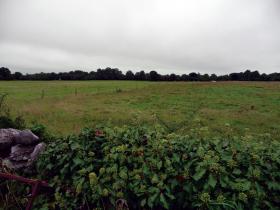‘Reign of terror at Craughwell’: Tom Kenny and the McGoldrick murder of 1909
Published in 18th-19th Century Social Perspectives, 18th–19th - Century History, Features, Irish Republican Brotherhood / Fenians, Issue 1 (Jan/Feb 2010), Volume 18
Galway’s 1923 All-Ireland hurling championship winning team, trained by Tom Kenny (right, in suit and cap, and inset). (Connacht Tribune)
During the last years of the nineteenth century Craughwell was one of the most violent corners of Ireland, and several murders were committed by members of the Irish Republican Brotherhood (IRB) as part of its struggle against local landlords to create a better life for the poor small farmers and labourers of the region.
Tom Kenny
By the 1890s, however, land agitation in Ireland had fallen away, and it was largely Tom Kenny who re-ignited the struggle for land in south Galway. He joined the United Irish League, the Gaelic Athletic Association, the IRB and—later—Sinn Féin, and he revived an old agrarian secret society that had existed in the county during the 1870s and 1880s. We do not know what motivated Kenny, since he left no account of his own life, and most of what we know about him is based on accounts of his actions contained in British police reports and in newspapers that do not reveal his deeper thoughts and motivations. We do know, however, that tradesmen in nineteenth-century Ireland often felt that British rule had been detrimental to their economic interests, and he probably believed that political independence would be economically beneficial to Ireland. He must also have been influenced by the intense poverty of the small farmers and labourers of south Galway, whose livelihoods had been threatened by a number of serious economic recessions during his lifetime and whose living conditions he dedicated much of his life to improving.
 Some Irish farmers had benefited from land purchase legislation introduced by the British (especially after the Wyndham Land Act of 1903, which effectively enabled all Irish tenants to purchase their farms) but many farmers lived on holdings that were too small to provide them with a reasonable standard of living whether they owned them or not. Kenny’s secret society was dedicated to the cause of implementing land redistribution and forcing the landlords and big farmers of the county to break up their grazing farms for distribution among the rural poor. He believed that political independence would inaugurate a social revolution that would redistribute wealth and resources among the hundreds of small farmers, tradesmen and landless labourers who flocked into his secret society.
Some Irish farmers had benefited from land purchase legislation introduced by the British (especially after the Wyndham Land Act of 1903, which effectively enabled all Irish tenants to purchase their farms) but many farmers lived on holdings that were too small to provide them with a reasonable standard of living whether they owned them or not. Kenny’s secret society was dedicated to the cause of implementing land redistribution and forcing the landlords and big farmers of the county to break up their grazing farms for distribution among the rural poor. He believed that political independence would inaugurate a social revolution that would redistribute wealth and resources among the hundreds of small farmers, tradesmen and landless labourers who flocked into his secret society.
The Widow Ryan
As part of this struggle, Kenny wanted the small, sixteen-acre farm at Templemartin to be divided up among the members of his secret society. The landlord, Lord Clanricarde, had other ideas, however, and instead a returned migrant, Mary Ryan, began renting the farm with the blessing of the local branch of the Home Rule movement, the United Irish League (UIL). Mrs Ryan was a brave woman, a native of Craughwell, a widow with a young family whose husband had died in the United States and who now faced the might of Tom Kenny and his secret society. Shots were fired in the field next to her house as she walked home, her hay was burned, the postman would not speak to her, and the walls that surrounded her farm were knocked in an attempt to make her give up the farm to Kenny. Custom had it that an unfenced farm would revert to commonage and could be used for common grazing by the people of the townland. When McGoldrick was shot he was overseeing the rebuilding of the farm walls that would allow Mrs Ryan, the UIL and Lord Clanricarde to successfully defy Kenny, and to secure the farm from his secret society. Kenny could not let this happen, and members of his society were instructed to fire shots at Coady and Malone to frighten them off, and to let the farm become a common treasury for all.
Kenny had not, however, anticipated McGoldrick’s zeal to uphold ‘law and order’, and after the killing, two members of his secret society—Michael Dermody and Thomas Hynes—were tried for McGoldrick’s murder. The main evidence against them came from an agricultural labourer from Rosmuc called Bartley Naughton, who is widely believed to have been bribed by the police to say that he had witnessed the killing from the railway bridge. Naughton’s evidence against Hynes and Dermody was soon revealed to be ‘a pack of lies’, according to the judge, and with a little help from Kenny (who raised a substantial amount of money for their legal defence and also visited some of the jurors) they were released in May 1910 to a hero’s welcome, and a popular ballad was later composed about them.
Class war

RIC reconstruction of the murder scene in 1910, with another constable standing in for McGoldrick and showing what he looked like when found. (National Archives)
But Tom Kenny had—in the view of the shopkeepers and big farmers of the locality—got too big for his boots. His violent agitation to break up the big grazing farms of south Galway and divide them up among the poor farmers and labourers threatened the power, position and prestige of the local middle class. Martin Hallinan, Michael Clasby and Bartholomew Cawley, all of whom were shopkeepers and publicans in the parish, organised a campaign of violence of their own with the intention of knocking Kenny off his perch. Kenny had by now joined Sinn Féin while Hallinan was the leader of the local branch of the UIL, and this political rivalry heightened the enmity between them. Moreover, the conflict was also a class struggle, with Hallinan representing the local bourgeoisie and Kenny standing up for the tradesmen, small farmers and labourers in the parish. The ‘dispute’ flared up at the pig fair held in the village in December 1910, which witnessed supporters of Kenny and supporters of Hallinan trading punches, and over the following twelve months at least 60 violent assaults were perpetrated by Hallinan’s supporters on their bitter rivals. Kenny’s supporters responded in kind but were at a disadvantage because the Royal Irish Constabulary (who, unsurprisingly, also hated Kenny) were happy to turn a blind eye to Hallinan’s brutal attacks on their common enemy. Hallinan also had the moral advantage because the Catholic bishops and priests used the pulpits of east Galway to warn the young men of the county against joining Tom Kenny’s secret society, and favoured the moderate Home Rule politics of Hallinan over Kenny’s violent republicanism. During the conflict of 1911, Kenny’s hurling team faced a hail of bullets as they got off the train at Craughwell station; Thomas Concannon, who employed Kenny to shoe the horses of the Galway Blazers, was persuaded to find another blacksmith; Kenny’s friends and supporters were assaulted and some of their houses were destroyed; an attempt was made to kill Kenny by throwing him out of an upstairs window; and by the end of the year many of his supporters had deserted him, he was financially ruined and reduced to answering the door of his house with a revolver in his hand. The events of 1911 constituted a drama of almost Shakespearian proportions, and witnessed the crushing of Tom Kenny by the state, the church, the Home Rulers and Martin Hallinan. Kenny’s own support basesthe IRB, Sinn Féin and the GAA—were not yet sufficiently powerful to enable him to withstand the onslaught.
Peace brokered by Clan na Gael

The field through which Constable McGoldrick pursued his attackers before being shot. (Alison Stenning)
At the beginning of 1912, however, Kenny played his trump card. By poisoning the foxhounds of the Galway Blazers at Turloughmore, he created a scandal that forced all of the nationalists of Galway to meet in an anxious attempt to resolve the dispute at Craughwell that was now getting out of hand. This crisis arose primarily because the Galway Blazers threatened to withdraw from the county if anything like this ever happened again, and this would have cost the local economy about Ä100,000 in today’s money. Local nationalists—many of whom were shopkeepers and tradesmen who benefited from the Blazers’ presence—did not want this particular goose to stop laying its golden eggs, and so Kenny and Hallinan were persuaded to bury the hatchet, and their reconciliation was lubricated by a pay-off from some members of Clan na Gael in Boston. Ostensibly the violent dispute was over, but there were later attempts to blacken Kenny’s reputation, and he never quite regained his former position after 1912. The member of the secret society who had actually shot McGoldrick and who had escaped arrest spent the rest of his life worrying about what he had done, and confessed to his priest each month that he had murdered McGoldrick. Despite being told that he was forgiven, the Craughwell murder preyed on his mind so much that he never married—although he owned a farm—and he remembered the shotgun that he had been given in January 1909 as the cause of his misfortune. Michael Dermody, who was from a particularly poor family, contracted tuberculosis in 1916 and died in Gort workhouse, while Thomas Hynes lived into his 80s. Bartley Naughton emigrated to California and ended his days there. And poor Martin McGoldrick did not live to see his 25th birthday, and died a victim of the conflict between the British state and Tom Kenny’s revolutionary secret society.
Epilogue
What is Tom Kenny’s legacy? The Galway Rising would not have happened without him, since it was the hundreds of small farmers, tradesmen and labourers whom he had politicised and organised who became the soldiers of the volunteer army that took on the British state in Galway in April 1916. Kenny himself escaped after the Rising to Boston, where he renewed his friendship with Jim Larkin and joined the Socialist Party, and when he returned to Craughwell after the Civil War he was a confirmed socialist. Independent Ireland did not provide fertile ground for his socialism, however, and apart from his participation in Saor Éire in 1931 and ongoing involvement in the GAA (he trained Galway’s first All-Ireland winning hurling team in 1923), he did not play a prominent part in Irish politics during the two decades before he died in 1947. Today few people remember who Tom Kenny was—although the GAA pitch at Athenry is named in his honour—but at the beginning of the twentieth century the chief secretary asked whether Ireland was to be governed by a water bailiff in Dublin (meaning Major John MacBride) and a blacksmith in Galway (Tom Kenny), such was the level of his influence in the country. HI
Acknowledgements
The author is grateful to three local historians—Gerry Cloonan, Andy Feeney and Maura Lyons—for sharing with him their stories about the Craughwell murder.
Fergus Campbell is Reader in Social and Cultural History at Newcastle University and is currently writing a history of Craughwell.
Further reading:
F. Campbell, Land and revolution: nationalist politics in the west of Ireland, 1891–1921 (Oxford, 2005).
F. Campbell, The Irish establishment, 1879–1914 (Oxford, 2009).
















